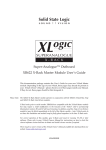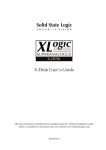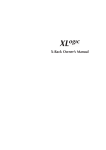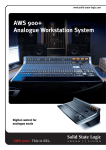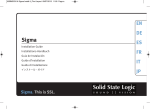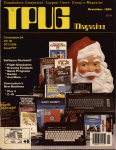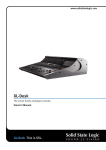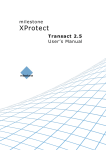Download Solid State Logic XR622 Music Mixer User Manual
Transcript
Solid State Logic S O U N D | | V I S I O N SUPERANALOGUE X-RACK Super-Analogue™ Outboard XR622 X-Rack Master Module User’s Guide This documentation package contains the User’s Guide for your new X-Rack Master module. Depending on the age of your X-Rack, these pages may already be present in your X-Rack Owner’s Manual – please check to see if these pages match your Manual. If they do not, these pages should be filed alongside it. Please Note. The XR623 X-Rack Master module operates in conjunction with the XR625 X-Rack Mic Amp and XR623 X-Rack Line Return modules. X-Rack units prior to serial number XRK0110 are compatible with the X-Rack Master module but may require a small modification to the buscard; if the ‘SOLO’ LED is permanently illuminated, resistors R1 and R2 will need removing. In addition, any Mic Amp or Line Return module(s) must be fitted immediately to the left of the Master module – later X-Rack units do not have this limitation and modules may be freely placed anywhere in the later X-Rack units. For correct operation of this module, your X-Rack unit must be running V1.2/0 or later software. Please refer to your X-Rack Owners Manual for instructions on how to check the current software version and how to obtain and install a newer version if required. There may be a newer version of the X-Rack Owner’s Manual available for download from our website ( http://www.solid-state-logic.com ) 82S6XR0F0A F. F.1 The Master Module X-Rack Master Module Introduction Used in conjunction with the XR623 X-Rack Line Return module, the XR622 X-Rack Master module provides a complete small scale mix and monitor system for studios seeking a compact solution for mixing and monitoring in the analogue domain. A single X-Rack can provide up to 28 line level inputs. Additional racks can be connected via the ‘MIX BUS LINK’ connector on the rear of the X-Rack unit, allowing additional inputs to be added to the system if required. Note. X-Rack units prior to serial number XRK0110 are not equipped with a ‘MIX BUS LINK’ connector. F.2 The X-Rack Total Recall system allows session setups to be recalled instantly and can be archived as a MIDI SysEx dump to any MIDI sequencer. The monitor section controls can also be controlled remotely using MIDI controller commands from any MIDI controller. Up to three racks can be connected to an AWS 900 or AWS 900+ and integrated with the AWS 900 Total Recall system via the serial port. Connecting the MIX and REC outputs of the XR-622 to the MIX and REC Insert Returns of the AWS 900 and selecting INSERT SUM mode allows almost unlimited expansion of the number of line level inputs to the console. Connection INS RTN INS SND EXT MIX MON REC ALT MON FOL MON The rear panel of the module carries a pair of 25-way ‘D’ connectors. The left-hand connector provides the main and alternate Monitor outputs as well as a stereo External Input and the Mix Bus Insert Return. The right-hand connector provides Mix and Record Bus outputs along with the Mix Bus Insert Send and a Follow-Monitor (prelevel control) output. All outputs (apart from the headphone output) operate at a nominal level of +4dBu and are configured to drive standard line level inputs. Level compensation for feeding 600Ω inputs from the Bus, Insert and Monitor outputs is provided by removable jumpers – refer to Section F.3.4 for details. XR622 SEL F.3 0 3 6 9 12 15 18 24 30 36 42 48 MONITOR Operation As well as a compact stereo monitor section, the X-Rack Master module contains the mix amps and outputs for the X-Rack’s internal Mix, Record and Solo/AFL busses. The Mix bus is intended to be used as the main mix bus and includes a balanced insert point immediately before the Mix level control. The Record bus provides a direct path to a DAW (or any other recorder), allowing the Mix bus to be used to provide a monitor mix while recording one or more inputs via the Record bus. If the X-Rack is fitted with XR621 Mic Amp modules these can be routed directly to the Record bus using the ‘REC L’ and ‘REC R’ switches on the XR621 module. F.3.1 Mix Section 1 This section carries all of the Mix bus controls; the ‘MIX LEVEL’ control allows the overall gain of the Mix bus to be adjusted (the Record bus level is fixed). The ‘INS’ switch brings the Mix Bus Insert Return into circuit (the Insert Send is permanently active) whilst the ‘SUM REC’ and ‘INS SUM’ switches allow the Record bus and Insert Return to be summed with the Mix bus to allow for summing of additional mix sources. The ‘MON’ switch enables the Mix output to be replaced with whichever source(s) have been selected for the Monitor section. MIX 1 SUM REC MON MIX LEVEL INS INS SUM MONITOR MIX AFL REC SOLO EXT LEVEL ALT MONO DIM CUT Page F-1 X-Rack Owner’s Manual F.3.2 Monitor Section 2 The Monitor Section enables the Mix and Record busses or a stereo external input to be monitored, the source to monitor being set by either the ‘MIX’, ‘REC’ or ‘EXT’ switches either seperately or together, allowing great flexibility in recording and montitoring signals. The ‘EXT’ input would normally be playback from the main recorder or DAW. The selected monitor signals can be routed back to the Mix output using the MON switch in the Mix Section, allowing composite mixes to be easily recorded back to the master recorder or DAW ADC. If one of the ‘SOLO’ switches on any other X-Rack modules is active, the ‘SOLO’ LED will illuminate and the AFL bus will be switched to the monitor output in place of the selected signal. The level of the AFL signal can be adjusted with the ‘AFL’ control. The overall monitor level is set by the ‘LEVEL’ control and the ‘MONO’ switch allows quick mono compatibility checking. The ‘DIM’ and ‘CUT’ switches provide either partial (between –3 and –30dB) or full attenuation of the monitored signal as required. Metering of the selected source (or sources) is provided by the stereo bargraph meter 3 which measures the signal level immediately prior to the ‘LEVEL’ control. Two sets of stereo loudspeaker outputs plus a headphone amplifier are provided. The headphone socket is driven by a fixed gain amplifier immediately post the ‘LEVEL’ control and is un-affected by the loudspeaker ‘ALT’ switch. F.3.3 Expansion XR622 SEL 0 3 6 9 12 15 18 24 30 36 42 48 MONITOR MIX 3 SUM REC MON MIX LEVEL INS INS SUM MONITOR MIX AFL REC EXT LEVEL SOLO 2 ALT MONO DIM CUT Each of the three X-Rack busses (Mix, Record and Solo/AFL) are accessible externally through the ‘MIX BUS LINK’ connector on the rear of the X-Rack. Additional X-Racks can be connected via this connector, allowing additional inputs to be mixed together and feed a single Master module. The pinout for this connector is detailed in Section 5.2 of the X-Rack Owner’s Manual; if the connector listing is not present in your manual, a more recent copy may be downloaded from the Solid State Logic website ( http://solid-statelogic.com ). Note. Only one XR622 master module is required per system – connecting two or more X-Rack units fitted with XR622 modules together will cause serious gain errors and distortion (though it will not damage the system electronics). F.3.4 Configuration Dim Level The attenation applied to the monitor signal when the ‘DIM’ switch is active is set by the Total Recall processor. The default level is –15dB, it can be adjusted as follows: • Press and hold SETUP/MIDI until the SETUP/MIDI LED flashes. • Use the D-Pot to select ‘d1’ (DIM Level). Press the D-Pot to select this option. • Use the D-Pot to set the required level (between –3dB and –30dB). • Press the D-Pot once more to set the selected value and return to the setup menu or press and hold SETUP/MIDI until the SETUP/MIDI LED stops flashing to return to normal operation. MIDI Remote Controlling the ‘soft’ controls on the XR622 Master module via MIDI will require MIDI controls to be mapped onto the required Master module functions. This is accomplished as follows: • Press and hold SETUP/MIDI until the SETUP/MIDI LED flashes. • Use the D-Pot to select ‘m1’ (MIDI Setup). Press the D-Pot to select the MIDI Setup menu. • Use the D-Pot to select ‘ck’ (MIDI Channel). Press the D-Pot to select this option. • Use the D-Pot to set the MIDI Channel to listen to (‘01’ to ‘16’ or ‘al’ for ‘all’). Press the D-Pot to leave this option. Page F-2 X-Rack Master Module • Use the D-Pot to select ‘le’ (MIDI Remote Learn) and press SAVE to enable learn mode. • Operate any one of the ‘soft’ controls on the XR622 Master module. This will cause the LED of the selected control to flash (the ‘SEL’ LED will flash if either of the potentiomenters have been chosen). Assign a MIDI controller to the selected function by operating the required MIDI controller. Repeat the ‘operate – assign’ process for all required controls. • Press the D-Pot again to leave this option and return to the setup menu or press and hold SETUP/MIDI until the SETUP/MIDI LED stops flashing to return to normal operation. • Switch assignments can be reset to the system defaults by pressing COPY/DEL when in MIDI Remote Learn mode; the ‘Empty’ LED indicating when the assignments have been deleted. Default MIDI Controller Mapping MIDI Controller 1 2 3 4 5 6 7 8 9 Master Module Control MIX REC EXT ALT MONO DIM CUT AFL Level Monitor LEVEL Note. These configuration options are also covered in the main X-Rack manual. Level Compensation Each of the Insert Send, Mix Bus, Record Bus and Monitor outputs are provided with level compensation for driving low (600Ω) inputs. Level compensation is activated by removing a jumper for each output as follows: 600Ω Output Level Compensation Link LK1 LK2 LK3 LK4 LK5 LK6 LK7 LK8 Output Alt/Main Monitor Right Record Bus Left Record Bus Right Alt/Main Monitor Left Insert Send Left Insert Send Right Mix Bus Left Mix Bus Right Page F-3 X-Rack Owner’s Manual F.4 Performance Specification The following page contains audio performance specification figures for the X-Rack Master module. No other Solid State Logic products are covered by this document and the performance of other Solid State Logic products can not be inferred from the data contained herein. F.4.1 Measurement Conditions For each set of figures on the following pages, the specific unit and test setup will be stated at the beginning of that section. Any changes to the specified setup for any particular figure(s) will be detailed beside the figures to which that difference applies. F.4.2 Measurement References Unless otherwise specified the references used in this specification are as follows: • Reference frequency: • Reference level: • Source impedance of Test Set: • Input impedance of Test Set: 1kHz 0dBu, where 0dBu ≈ 0.775V into any load 50Ω 100kΩ • All unweighted measurements are specified as 22Hz to 22kHz band limited RMS and are expressed in units of dBu • All distortion measurements are specified with a 36dB/Octave low pass filter at 80kHz and are expressed as a percentage • The onset of clipping (for headroom measurements) should be taken as 1% THD • Unless otherwise quoted all figures have a tolerance of ±0.5dB or 5% • All measurements are made with the operating level switch set for +4dBu F.4.3 Mix Bus Performance Signal applied to one channel of an X-Rack Line Input module and routed to Mix Bus. Signal measured on Mix Output. All other inputs un-routed from the bus under test. Mix Bus Gain control set to 0dB. Gain Continuously variable from –∞ to 0dB Frequency Response ±0.1dB from 20Hz to 20kHz –3dB at 150kHz THD + Noise (+24dBu applied, 0dB gain) Equivalent Input Noise (Input terminated with 150Ω) < 0.005% from 20Hz to 10kHz, < 0.008% at 20kHz < –88dBu F.4.4 Record Bus Performance Signal applied to one channel of an X-Rack Line Input module and routed to Record Bus. Signal measured on Record Output. All other inputs un-routed from the bus under test. THD + Noise (+24dBu applied, 0dB gain) Frequency Response Equivalent Input Noise (Input terminated with 150Ω) Page F-4 < 0.005% from 20Hz to 20kHz ±0.1dB from 20Hz to 20kHz –3dB at 150kHz < –88dBu X-Rack Master Module F.5 Calibration Information The X-Rack Master module is factory calibrated and should only need calibration if a potentiometer or other component has been replaced or if it is suspected that there is a problem with calibration. In each of the following instructions it is assumed that the lid of the X-Rack has been removed and that power has been applied. It is also assumed that, unless otherwise specified, all switches are released and all front panel potentiometers are at unity or minimum position as appropriate. The required accuracy for each adjustment will be specified along with the target value. All level and distortion measurements should be made with audio-band 20Hz to 20kHz filters unless otherwise specified. All presets are accessible from the top of the unit. F.5.1 Mix Level Tracking Equipment Required: Test Signal: Input and Output: Unit Setup: Adjustment: F.5.2 Meter Level Equipment Required: Test Signal: Input and Output: Calibrated audio oscillator and audio level meter 1kHz sinewave @ +24dBu Oscillator to Insert Return Left Output to the audio level meter from Mix Bus Output (use Left or Right as instructed below) Select ‘INS’ and set ‘MIX LEVEL’ to centre. 1. Measure Mix Bus Output Left and note the reading. 2. Connect the oscillator to Insert Return Right. 3. Measure Mix Bus Output Right and adjust VR6 (‘TRACKING’) for a level which matches that measured in step 1. Calibrated audio oscillator and audio level meter 1kHz sinewave @ +24dBu Oscillator to Insert Return Left Output to the audio level meter from Follow Mon Output (use Left or Right as instructed below) Unit Setup: 1. Select ‘INS’ and set ‘MIX LEVEL’ to maximum. Adjustment: 1. Measure the Left ‘Follow Mon’ Output. Adjust the oscillator level to obtain +24dBu, if necessary. 2. Select 2. Adjust VR5 (‘0dB LEFT’) so that that the top left hand ‘red’ LED on the bargraph meter just illuminates. 3. Connect the oscillator to Insert Return Right. 4. Measure the Right ‘Follow Mon’ Output. Adjust the oscillator level to obtain +24dBu, if necessary. 5. Adjust VR4 (‘0dB RIGHT’) so that that the top right hand ‘red’ LED on the bargraph meter just illuminates. Page F-5 X-Rack Owner’s Manual F.6 Connector Details Ins Rtn, Ext, Mon, Alt Mon Ins Snd, Mix, Rec, Fol Mon Conn’ Type: Conn’ Type: Location: Pin 1 14 2 15 3 16 4 17 5 18 6 19 7 20 8 21 9 22 10 23 11 24 12 25 13 Rear Panel 25-pin ‘D’ Type Female Description Alt Monitor Out Right (+ve) Alt Monitor Out Right (–ve) 0V Alt Monitor Out Left (+ve) Alt Monitor Out Left (–ve) 0V Main Monitor Out Right (+ve) Main Monitor Out Right (–ve) 0V Main Monitor Out Left (+ve) Main Monitor Out Left (–ve) 0V External Input Right (+ve) External Input Right (–ve) 0V External Input Left (+ve) External Input Left (–ve) 0V Mix Insert Return Right (+ve) Mix Insert Return Right (–ve) 0V Mix Insert Return Left (+ve) Mix Insert Return Left (–ve) 0V n/c Headphones Location: Conn’ Type: Pin Tip Ring Sleeve Page F-6 Front Panel Stereo 1/4" Jack Socket Description Left 0V Location: Pin 1 14 2 15 3 16 4 17 5 18 6 19 7 20 8 21 9 22 10 23 11 24 12 25 13 PL2 Location: Conn’ Type: Pin n/a Rear Panel 25-pin ‘D’ Type Female Description Follow Monitor Right (+ve) Follow Monitor Right (–ve) 0V Follow Monitor Left (+ve) Follow Monitor Left (–ve) 0V Record Output Right (+ve) Record Output Right (–ve) 0V Record Output Left (+ve) Record Output Left (–ve) 0V Mix Output Right (+ve) Mix Output Right (–ve) 0V Mix Output Left (+ve) Mix Output Left (–ve) 0V Mix Insert Send Right (+ve) Mix Insert Send Right (–ve) 0V Mix Insert Send Left (+ve) Mix Insert Send Left (–ve) 0V n/c Internal 16-pin IDC Plug Description For Future Expansion X-Rack Master Module F.7 Physical Specification * Depth: Height: Width: 200mm / 7.9 inches 275mm / 10.9 inches including front panel knobs, excluding connectors including front panel knobs and connectors 35mm / 1.4 inches 49mm / 1.9 inches front/rear panels overall width (front and rear panels are offset) 171mm / 6.75 inches Weight: 260g / 9.5 ounces Boxed weight: 460g / 16.5 ounces Boxed size: 190mm x 290mm x 70mm / 7.5" x 11.5" x 2.5" * All values are approximate F.8 Environmental Specification As per X-Rack – see page 19. Page F-7 X-Rack Owner’s Manual Page F-8










